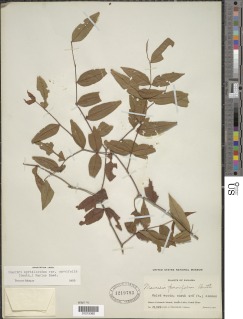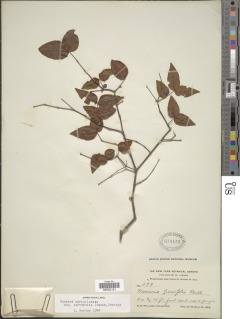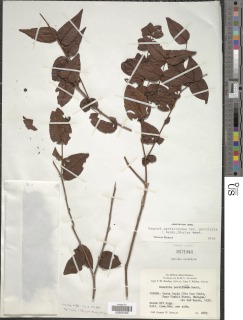

|
|
|
|
Family: Melastomataceae
arracheche, more...guayabillo, sequara
|
Description: A shrub or treelet of the forest understory with a straight stem and horizontal, opposite branches. Leaves are opposite, regularly-spaced and in a flat plane, with many per branch; the branches are long. Leaf margins are undulate, and the leaves are narrow and pointed. Secondary veins are inconspicuous. There is no petiole, so the leaves grow right against the branch. Branchlets are slightly winged, or at least with noticeable ridges. Reproduction: Flowers are small, white, appear singly at the base of leaf pairs. There are two flowering periods, January-March and August-September. Fruits are small berries, green than purple or black, with a crown at the apex formed of remnants of the flower. They mature October-November and again in April and May. Distribution: One of the dominant understory species at Barro Colorado Islan, but remarkably absent at Soberania. Much less common at Sherman, and rare in the upper Chagres. Strictly a species of the forest interior. Similar Species: This species is easy to spot and easy to learn, at least when you look closely and see that there is no petiole at all. It can be confused with LK eugeoe Eugenia oerstediana LK2 at Barro Colorado, which also has opposite leaves with an undulate margin, but Eugenia and all the Myrtaceae have petioles, although sometimes rather short ones. LK lafopu Lafoensia punicifolia LK2 also has narrow, opposite leaves, but they also have a petiole and are not wavy-margined. Two other Mouriri species occur in the Canal area, but they are restricted to wet and montane forests; they have the same unmistakable leaves, but of a larger size. Note that Mouriri is taxonomically a Melastomataceae, but it lacks the conspicuous ladder-like venation of most members of the family (such as LK micoar Miconia argentea). LK2 Descripción: Árbol o arbusto de 2 a 7 m de alto. Tronco ramificado a baja altura. Corteza exterior negra. Ramitas terminales dicótomas y de forma cuadrangular. Aunque la familia no presenta estípulas, la especie posee una estructura interpeciolar semejante. Hojas simples y opuestas, de 3-8 x 2-3 cm, lanceoladas, con ápice agudo o acuminado, bordes ondulados y base redondeada o cordada. Las hojas del género Mouriri no tienen la nervadura típica de familia Melastomataceae. Pecíolo ausente. Flores blancas y axilares. Frutos globosos, de 0.7-0.9 cm de largo, verdes y con una estructura en forma de corona en la punta, tornándose morados o negros al madurar. Datos Ecológicos: La especie crece a bajas y medianas elevaciones, en bosques húmedos o muy húmedos. En Panamá se encuentra a través de todo el país. Florece y fructifica de agosto a noviembre, y de enero a mayo. Las flores son visitadas por abejas y otros insectos Las semillas son dispersadas por animales. Especies Parecidas: A menudo se confunde con plantas de la familia Myrtaceae principalmente del género Eugenia, pero en Eugenia las hojas tienen pecíolo, y en M. myrtilloides no tienen pecíolo. También se puede confundir con LK lafopu Lafoensia punicifolia LK2 , pero en L. punicifolia las hojas tienen pecíolo y un poro pequeño en el ápice del envés, lo cual no ocurre en Mouriri. Usos: Tronco de diámetro pequeño, empleado para la fabricación de mangos de herramientas y tajonas. M. parvifolia Benth. Guayabillo, Arracheche, Solacra, Cierito, Kenna Shrub, usually 2-4 (15) m tall, essentially glabrous, divaricately branched; younger stems ribbed, the ribs 4, thin, sharp, deciduous on older wood. Leaves sessile; blades lanceolate or ovate-lanceolate, acute to acuminate, rounded to subcordate and inequilateral at base, 3-8.5 cm long, 2-3 cm wide, pellucid-punctate, the margins undulate; vein 1 (the midrib). Fascicles axillary, bearing few flowers; pedicels with opposite-decussate bracteoles; flowers 5-parted; hypanthium and calyx together 5-6 mm long, campanulate, the lobes narrowly triangular, to 3 mm long, persisting in fruit; petals white, acuminate, 4-6 mm long, soon falling; stamens 10, exserted, shorter than style; anthers ca 2 mm long, with 2 subterminal, short, porelike slits, the connective darker, thickened toward base, bearing a dorsal gland prolonged at base; ovary inferior; style elongating to more than twice the length of the flower. Berries round, 7-13 mm diam, with persistent hypanthia, green turning deep purple at maturity, indehiscent or splitting open irregularly at maturity, ephemerally sweet; exocarp thin; mesocarp purplish, 2-3 mm thick; seed 1, subglobose, to 7 mm broad, with minute longitudinal ridges. Croat 11790. Common in the forest. Flowers sporadically throughout the year, mostly in August and September but also in the middle of the dry season. The fruits probably develop in about a month. |




































